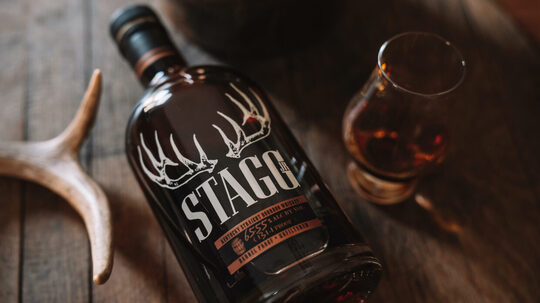Blog
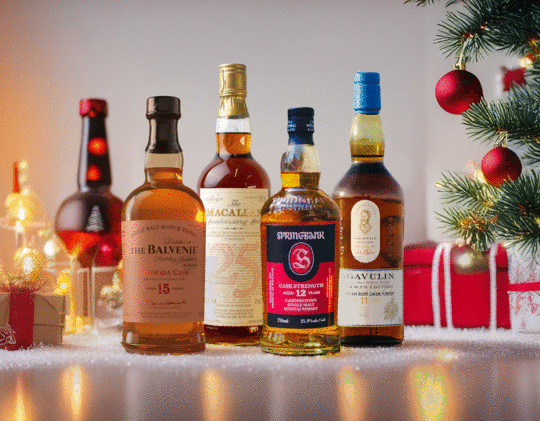
Shopping for scotch doesn't have to feel like defusing a bomb. Whether you're buying for your whisky-obsessed uncle, that colleague who's just discovered single malts, or the friend with a cabinet full of bottles you can't pronounce, this guide has you covered. From budget-friendly gems to bucket-list bottles, here's how to nail scotch gifting this Christmas.
Nick Offerman's fourth collaboration with Lagavulin takes an unexpected turn—Caribbean rum cask finishing on 11-year-old Islay whisky. After aging in ex-bourbon and sherry casks, this spends eight months in rum barrels, adding tropical fruit notes to Lagavulin's signature peat smoke. Drinkhacker scored it an A, proving that sometimes the unexpected combinations work beautifully.
Now here's a scotch only a select few can pronounce properly—if you want to watch your gift recipient stumble over the name for the next five minutes, this is your champion. This travel retail exclusive is an intriguing marriage of Bunnahabhain single malts finished in ex-red wine casks. For someone who wants to explore Islay without getting knocked over by peat smoke, this delivers coastal character with vibrant fruit complexity. It's unpeated Islay done right—even if saying it correctly remains delightfully wrong.
Another travel retail gem worth hunting down. Four different cask types—ex-bourbon barrels, quarter casks, virgin American oak, and European oak hogsheads—create golden, creamy peat smoke with toasted vanilla, sandalwood, and hints of pine. Even the most seasoned scotch drinkers likely haven't tried anything aged in four different cask types, making this an ideal gift when you want to offer something genuinely interesting while staying on a budget.
Probably one of the most iconic scotches of all time, and there's a reason for it. Blue Label is the Disneyland version of Scottish whisky, and that's meant as the highest compliment. It distills the essence of what makes scotch great into one approachable bottle—clean, pristine, and idealized. Selected from only one in 10,000 casks, it works for first-time drinkers and jaded enthusiasts alike.
Created in 1953 to celebrate Queen Elizabeth II's coronation, Royal Salute hasn't changed since—and that's intentional. This 21-year-old blend delivers luscious pears, orange marmalade, and hazelnut cream. The blenders at Chivas Brothers keep the exact composition close to the vest—perhaps channeling the late monarch's discretion in keeping calm and carrying on without oversharing. The sapphire blue ceramic decanter is, in my opinion, one of the most beautifully designed bottles on the market—a work of art that deserves a permanent place on the shelf even after the whisky is gone. Plus, we're offering best-in-market pricing right now.
Springbank remains one of Scotland's most respected distilleries, and this cask strength 12-year-old shows why. Matured in ex-bourbon and sherry casks, then bottled at varying proofs depending on the batch, it delivers caramel, marzipan, honey, smoke, peat, and oak in beautiful harmony. For the person who appreciates craft and authenticity, Springbank does everything on-site from malting to bottling—and you can taste that commitment.
Every Macallan drinker has been waiting for this one—only just released, this is the gift for the Macallan enthusiast in your life. For years, fans faced an impossible choice: age or proof. The new 12 Year Old 110 Proof finally bridges that gap, combining 12-year maturity with bold, concentrated flavors. Matured exclusively in European oak casks seasoned with sherry wine in Jerez, the 110 proof hits that sweet spot where the whisky retains approachability while delivering the concentrated character that makes cask strength expressions so compelling.
This scotch was just named #2 on Whisky Advocate's top whiskies of 2025, receiving 95 points—the highest rated scotch on the list. Released in April 2025, most people haven't even tried this yet. Aged in European and American oak, then finished for more than 4 years in oloroso and palo cortado sherry casks, that extended finishing lends incredible alluring sweetness to the whisky. For someone who thought they knew Oban, this will be a revelation.
Inspired by Ethiopian Arabica coffee beans but without any coffee flavoring added, this is the perfect gift for giving a seasoned scotch drinker something different and experimental. The Harmony Collection lets fans experience Macallan from a different perspective than standard core-range expressions. Matured in ex-bourbon American oak and refill sherry oak at 44% ABV, the highlight is the delicious interplay between bitter and sweet—if your recipient loves both coffee and whisky, this will be right up their alley.
Balvenie finishes this 15-year-old in Pedro Ximénez sherry casks hand-picked from Spain, creating explosive ripe single malt swimming in deep sherry notes. Bottled at 97.4 proof, Drinkhacker calls it "one of my favorite Balvenie releases in recent memory." For someone who's covered the standard age statements and wants to explore interesting cask finishes, this delivers without being too experimental.
We've hand-selected a collection of bottles that would fit seamlessly into any high-end scotch collection. These are investment-worthy expressions on the pricier side, representing the kind of bottles that true connoisseurs dream about. Whether you're celebrating a major milestone or giving an unforgettable gift to someone with discerning taste, these deliver prestige, rarity, and exceptional quality in equal measure.
With only 166 bottles produced from a single cask selected by Malt Master Brian Kinsman, this 39-year-old represents genuine rarity. Distilled in 1977 and bottled at 44.9% ABV, each hand-numbered bottle comes with aged oak, apple, toasted nuts, cream, tannins, and caramel-dipped citrus. For the serious collector who has everything else, this offers something genuinely exceptional and increasingly scarce.
Distilled in 1972 and bottled in 1998, this represents the era collectors obsess over—when Macallan's profile was dramatically different from today. This is full sherry maturation from the golden age, delivering big ripe red fruit, date, prune, dark chocolate, and earthy mineral complexity at 43% ABV. With only one bottle available, this represents old-school Macallan character that's virtually impossible to find today.
Released in 2016 to celebrate Lagavulin's bicentennial in a run of just 8,000 bottles worldwide, this 25-year-old shows what extended aging does to Islay peat. Quarter-century maturation softens the signature smoke into something remarkably elegant—refined coastal character rather than medicinal punch. For the Islay collector, this anniversary release represents distillery history that only gets harder to find.
If there's a bucket-list bottle for any scotch drinker, this is it. Matured exclusively in hand-picked sherry seasoned oak casks from Jerez for a minimum of 30 years, this consistently scores well in international competitions. Honeyed figs, dates, rich fruit cake, prunes, stem ginger, and a long finish with oak, spice, and orange at 43% ABV—this is as prestigious as scotch gets. The price reflects both the age and rarity, but for the centerpiece bottle, nothing matches this.
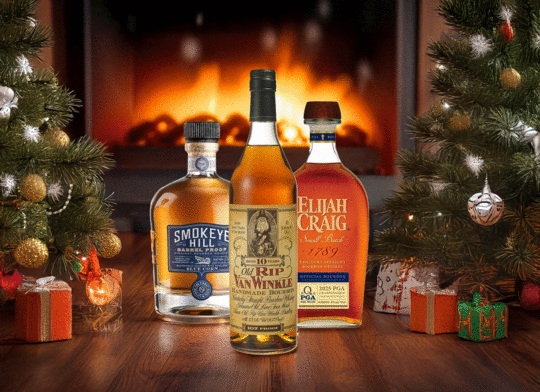
Look, finding the perfect bourbon gift doesn't have to send you spiraling down a Reddit rabbit hole at 2 AM. Whether you're shopping for your boss who "knows whiskey" or your college buddy who's finally graduated from Jack and Coke, we've got you covered.
If you want to give a gift that screams "if you know, you know" or shows genuine good taste, this is the bourbon. Fred Minnick's ASCOT Awards named it Best Bourbon of 2024, beating George T. Stagg and other industry heavyweights. Made from Indiana Heirloom Blue Corn and bottled uncut, unfiltered at around 130 proof in Colorado Springs, this relatively unknown brand is producing exceptional cask-strength bourbon at a remarkable price point of only $89. It's proof that great bourbon doesn't always come from familiar names and is sure to impress any bourbon lover in your life!
Sometimes you just can't go wrong with a classic. Eagle Rare 10 Year is one of the finest bourbons produced by Buffalo Trace—impeccably balanced and remarkably complex. This beautifully refined Kentucky straight bourbon was once a single barrel expression but has adopted a new production method, though it maintains the exceptional flavor that makes it difficult to find on shelves. Given its popularity with bourbon purists and its accessible price point, this is an extremely safe gift that anyone can appreciate and enjoy.
Got a golfer or golf fanatic in your life? This annual commemorative celebrating the PGA Championship is a hole-in-one gift. This 94-proof small batch offers quality and collectibility without the premium price tag—consider it par for the course when it comes to thoughtful bourbon gifts. It's well-crafted whiskey that works both for golf enthusiasts and as an accessible entry into limited editions.
Ask any bourbon drinker about their dream pour, and you'll likely hear the Van Winkle name mentioned. The price tag reflects that prestige—this sits on the heftier side at $799.99 . But here's the thing: it's actually one of the more accessible Van Winkle expressions while maintaining every bit of the family's legendary status. For the bourbon lover who has everything else, this checks a major box. If you really want to spoil the Bourbon lover in your life, this is the bottle to get.
Part of Buffalo Trace's legendary Antique Collection, George T. Stagg is uncut, unfiltered, and regularly clocks in over 140 proof. Because of its cult like following, bourbon fanatics will likely never see this bottle in their local liquor stores and is always sold above MSRP. At least 15 years in the barrel creates intense maple, oak, and caramelized sweetness that can be overwhelming at full strength. Add a few drops of water, though, and this powerhouse opens up beautifully, revealing surprising complexity beneath all that heat. It's bold bourbon at its finest.
These are genuinely rare finds—we only have two in stock. The '90s set includes Austin Nichols Wild Turkey Real Kentucky (43.4%), six Wild Turkey branded glasses, poker chips, and playing cards. The 2000s version comes with similar gear and a different bottle. For Wild Turkey's devoted following, these aren't just quirky collectibles—they're time capsules from an era when distilleries had more fun with their marketing. A super unique gift that any Wild Turkey fan would be lucky to have.
Want to give someone something truly interesting? How about a bourbon that isn't even available in the United States? This bottle carries genuine bourbon history—during the industry's dark ages, Four Roses couldn't sell straight bourbon in America and focused entirely on Asian markets just to survive. Their straight bourbon didn't return stateside until 2002. This Japan-exclusive Super Premium offers a fruitier, more mature profile than Four Roses Small Batch and represents one of the few accessible Japanese exclusives. It's tangible bourbon history most Americans don't even know exists.
With many citing this as bourbon of the year for 2025, it was hard not to include it on this list—especially given its incredibly unique aging process. Bardstown acquired 300-year-old French oak barrels originally harvested for Notre Dame Cathedral's reconstruction. They finished a blend of five premium bourbons (aged 9-18 years) in these historic barrels for 14 months, bottling at 110.1 proof. The result is a genuine contender that's literally history in a bottle.
Everybody has heard of Buffalo Trace bourbon—it's a staple in many collections. However, not many have even heard of or had the chance to try this super limited release. In 1999, warehouse manager Ronnie Eddins traveled to the Ozarks to personally select 96 specific trees for an unprecedented experiment. They separated them by grain type, cut each into sections, seasoned the staves for different periods, then created 192 different single barrels with varying recipes and entry proofs.
Here's the perfect gift for someone who has everything: Prichard's Double Chocolate Bourbon brings together Tennessee whiskey tradition with artisan chocolate from Olive and Sinclair. This unusual bourbon gets double-barrel aged for up to 14 years before being infused with single-origin cacao beans, creating genuine chocolate essence rather than liqueur sweetness at 90 proof- perfect for the holiday season. The Ultimate Spirits Challenge awarded it 90 points for a reason—this actually works.
Here's a bottle most of your bourbon fanatic friends have been keeping their eyes out for in local liquor stores but likely haven't seen yet—it was one of 2025's most hyped releases. Everybody has tried Eagle Rare 10, and everybody's been hunting for this 12-year expression. Buffalo Trace has bridged the gap between the beloved 10-year and coveted 17-year releases with twelve years at 95 proof. Five extra proof points and two additional years create greater structural complexity while maintaining Eagle Rare's approachable character. Gift this and you'll likely hear "I've been wanting to try this" or "Where did you find this?" Get in early before allocation madness takes hold.
December 18, 2024, marked a historic moment when the U.S. Alcohol and Tobacco Trade Bureau officially recognized American Single Malt Whiskey as a distinct category. Jack Daniel's American Single Malt represents the distillery's take on this new category—something unique and interesting for the everyday bourbon drinker to venture into new territory while having that familiar Jack Daniel's label in front of them. Our partners at Breaking Bourbon describe it: "An American single malt that plays it safe yet is able to retain classic Jack Daniel's characteristics."
For collectors who understand bourbon history, A.H. Hirsch represents the ultimate get. Distilled in 1974 at Pennsylvania's now-abandoned Michter's distillery, only 400 barrels were salvaged, yielding just 4,244 cases worldwide. These "rescued" bourbons were bottled at 91.6 proof after 16 years. Whether you find Blue Wax or Gold Foil, you're acquiring increasingly rare liquid history. Warm oak, honeysuckle, caramel, and cinnamon spice define a bourbon that collectors hunt worldwide—and that only becomes scarcer with time.
This discontinued, pre-2016 squat bottling proves a hard truth: bourbon quality has changed. At 90 proof, this wheated bourbon performs well beyond recent Buffalo Trace releases from the last decade. These archive bottles represent an era when production focused more on quality than meeting demand—before the allocation frenzy reshaped the industry. For collectors, these dusty bottles offer tangible proof of bourbon's evolution and serve as benchmarks for what Weller once delivered consistently.
This is probably one of the rarest and most collectible bottles you could ever purchase on the market—and it definitely shows in the price tag. We have only one in stock. At 25 years old, Eagle Rare 25 marks the oldest and rarest expression released from the Eagle Rare portfolio, limited to just 200 bottles worldwide. This groundbreaking 101-proof bourbon, part of Buffalo Trace's $20-million experimental Warehouse P program, is presented in a hand-blown crystal decanter featuring a sterling silver wing and custom glass eagle. For the serious collector who wants something truly exceptional, this is as rare as it gets.
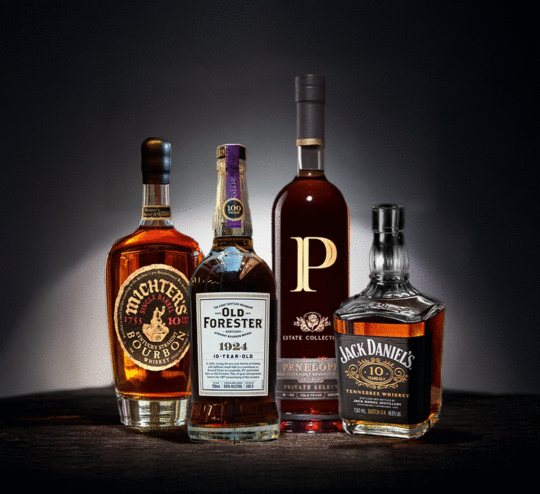
Ten years in a barrel represents a sweet spot in bourbon maturation—long enough for serious depth and complexity, but not so long that oak overtakes everything else. In 2025, we're seeing more distilleries proudly sporting double-digit age statements, a welcome trend after years of younger releases. Whether you're looking for a special occasion sipper or building out your home bar, these five 10-year expressions represent the best of what this age category has to offer.
Michter's 10 Year continues to set the standard for decade-aged bourbon. The single-barrel program sources barrels at least 10 years old, with some rumored closer to 15 years depending on barrel quality. Each expression goes through Michter's bespoke filtration process before being proofed down with Kentucky limestone water to a very drinkable 94.4 proof.
This is quintessential sipping bourbon that also makes one hell of an Old Fashioned. The nose can be a touch oaky, but that helps prepare you for the insane depth this whiskey delivers. Michter's 10 balances maturity with elegance, never letting age overwhelm the distillate character. The single-barrel nature means each bottle varies slightly, but quality control remains consistently excellent—earning the top spot for its uncompromising quality and exemplary patient aging.
The Whiskey Row Series has hit high quality marks since 2015, and 1924 continues that tradition with intriguing twists. This expression debuts a new mashbill (79% corn, 11% rye, 10% malted barley) created specifically for the release—showing Brown-Forman's dedication to the product. More notably, it carries a 10-year age statement, hopefully signaling major Kentucky distilleries returning to double-digit ages.
Bottled at 100 proof, 1924 delivers an instantly noticeable creamy mouthfeel, blending red currant, cranberry, and plum with layers of graham cracker and light maple. It leans toward elegance over potency—straightforward but effective as an easy sipper that wears its heart on its sleeve. The bourbon captures what makes Old Forester great, finding a sweet spot between other Whiskey Row releases, Statesman, and certain Single Barrel selections.
Jack Daniel's aged series shows what their Tennessee whiskey achieves with extra time in wood. Batch 4 of the 10 Year delivers a balanced blend of sweet and oak notes. Released alongside 12 and 14-year versions (with the company cleverly proofing each according to age), the 10 Year is the most approachable of the trio.
While Batch 3 leaned oak-forward, this year's release finds better equilibrium. The nose is full of pleasing sweet scents that mingle beautifully, while the midpoint delivers creamy caramel sweetness with buttery mouthfeel. Spiced and dry notes emerge as you explore the layers, punctuated in the finish. Compared to higher-proof older siblings, the 10 Year offers a slightly less aggressive experience—balanced, flavorful, and accessible while continuing to deliver quality four years into the aged series.
Of all the brands bottling MGP whiskey, only Penelope caught their attention enough to be acquired by MGP/Luxco in 2023. Founded in 2018 on purchasing and blending MGP whiskey, Penelope's Single Barrel Estate Collection showcases exceptional barrels selected from various warehouses and floors.
This 10 Year features MGP's LESV mashbill (75% corn, 21% rye, 4% malted barley), non-chill filtered and bottled at 98 proof. The profile captivates: sweet Cow Tales candy aromas give way to earthy apple chips, almond, and juicy plum. The palate delivers buttery toffee, vanilla custard, tangy cherry Jolly Ranchers, almonds, and warming clove. The finish brings cranberry juice that avoids tartness, concluding with cinnamon rolls and cream cheese frosting that lingers substantially. The mouthfeel transitions from thin to viscous with a gentle tingle. While cask strength dominates the market, 98 proof feels absolutely right here.
Modern Old Fitzgerald Bottled-in-Bond decanters have been fan favorites since 2018. Originally planned for five years, the series proved so popular that Heaven Hill's Max Shapira continued it indefinitely. The bourbons have ranged from 8 to 19 years old, making this 10-year Spring 2024 release toward the younger end—though a decade-aged bourbon is hardly young.
Bottled at 100 proof per bottled-in-bond regulations, this wheated bourbon delivers mature flavors while maintaining perfect balance. For fans of older wheated bourbons, this hits the sweet spot between youthful vibrancy and aged sophistication. Old Fitzgerald decanters are always in high demand and challenging to find, but if you track one down at reasonable markup, it's worth the hunt. The combination of Heaven Hill's wheat recipe, 10 years of aging, and bottled-in-bond transparency creates something special.
These five expressions represent the best of what 10-year bourbon offers in 2025. From Michter's single-barrel excellence to Jack Daniel's balanced maturity, Brown-Forman's elegant new mashbill to Penelope's exceptional MGP selections, and Heaven Hill's wheated masterpiece, there's something for every bourbon lover. The return of double-digit age statements signals good things for bourbon's future.
Explore our full 10 year bourbon collection here.
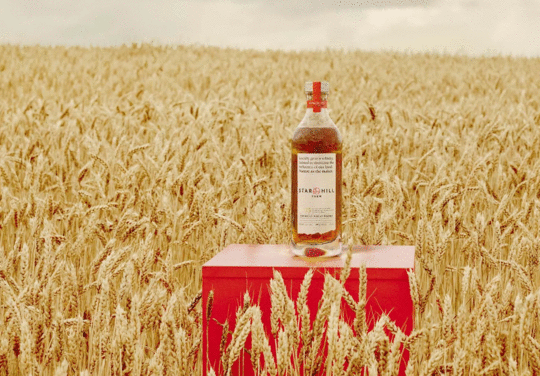
As whiskey consumers increasingly demand transparency and authenticity, estate whiskey has emerged as the answer. This grain-to-glass approach offers complete traceability from farm to bottle, representing both a return to distilling's agricultural roots and a bold statement in today's crowded market.
Estate whiskey means the distillery grows its own grains and handles every production step on-site. The Estate Whiskey Alliance (EWA), formed in 2023, certifies distilleries meeting specific standards: at least two-thirds of grains must come from land the distillery owns or controls, with milling, cooking, fermenting, distilling, barreling, aging, and bottling all happening at one location.
This model transforms distilleries into farmer-distillers—agricultural operations first, spirit producers second. It's a throwback to how American whiskey began, when farmers distilled their own harvests rather than sourcing from commodity suppliers.
Estate distilleries control variables impossible for traditional operations to manage. From soil health and irrigation schedules to grain variety selection and harvest timing, every decision impacts the final whiskey. This creates genuine terroir—spirits that express the characteristics of specific land and climate, much like wine.
The philosophy centers on quality over quantity. Estate operations can prioritize slow grain growth for better flavor development rather than maximizing yield. This attention to agricultural detail carries through to every production stage, resulting in whiskey that couldn't be replicated elsewhere.
The Alliance launched with seven founding members representing both pioneering estate operations and established brands embracing the model: (Saskatchewan, Canada), (Bardstown, Kentucky), (Ancram, New York), (Loretto, Kentucky), (Loretto, Kentucky), (Bardstown, Kentucky), and (Beaver Dam, Kentucky). The Alliance welcomes not just distilleries but also farmers, suppliers, academic institutions, and related organizations committed to advancing estate whiskey production.
Some states have created additional certifications. Nevada's 2019 estate law requires 85% of ingredients from distillery-controlled land. New York's Empire Rye mandate requires 75% New York-grown grain and in-state production for all steps. These regional programs add another layer of geographic authenticity.
in Nevada operates on 2,000 acres, growing all their grains including non-GMO corn, wheat, barley, and rye. Their portfolio includes a five-year straight bourbon, bottled-in-bond rye, and experimental Single Grain releases like 100% Wheat and 100% Oat whiskeys that demonstrate how grain choice shapes character.
in New York pioneered the modern estate distillery concept and helped develop the Empire Rye standards. in Illinois takes a similar farm-first approach with complete production transparency.
Major distilleries are joining the movement too. Heaven Hill, Maker's Mark, and Michter's have all established farming operations, betting that grain quality directly impacts whiskey quality.
Estate whiskey shares DNA with bottled-in-bond but serves a different purpose. The 1897 Bottled-in-Bond Act established consumer protections requiring single-distillery production, minimum four-year aging, and 100 proof bottling—crucial transparency when whiskey adulteration was rampant.
Estate certification adds the agricultural component, requiring distilleries to grow their own grains. Some whiskeys qualify for both designations, offering maximum transparency: verified grain source, single-site production, and federal quality standards.
Estate whiskey appeals to drinkers who value provenance and sustainability. These operations represent a commitment to doing things deliberately rather than efficiently, believing the extra effort produces distinctly better spirits.
The model often proves economically viable despite higher labor requirements. Vertical integration eliminates grain brokers and middlemen, with distilleries capturing value at every production stage. This can translate to competitive pricing despite the premium nature of the product.
As more consumers seek authentic stories and transparent production, estate whiskey's grain-to-glass narrative resonates. The EWA has created infrastructure making certification accessible and educating consumers on what estate designation means.
Whether you're exploring Nevada's grain-forward bourbons, New York's rye whiskeys, or limited estate releases from established brands, you're tasting something fundamentally different—spirits shaped by specific land, grown and distilled by people who control the entire journey from seed to sip. That's estate whiskey: farming and distilling united, proving that great whiskey truly begins in the soil.
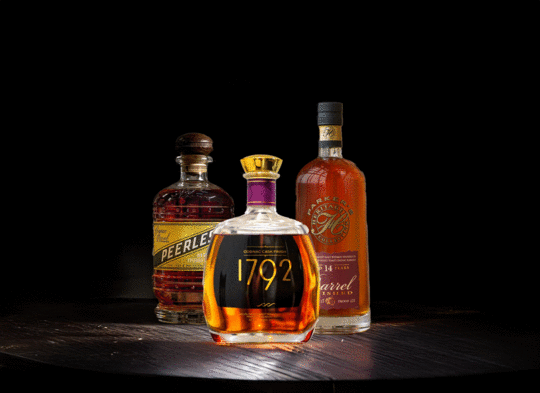
When mature whisky meets a used cognac cask, magic can happen—but only when done right. The French, who are the the sole producers of cognac, understand this balance better than anyone. Cognac-finished whiskies are emerging as some of the most opulent and complex expressions on the market, delivering a unique flavor profile that's captivating enthusiasts worldwide.
By law, cognac casks are crafted exclusively from French oak sourced from the legendary forests of Tronçais and Limousin—considered among the highest quality wood for casks in the world. These aren't just any barrels; they're vessels that have held exceptionally old cognac, often for 30 years or more, concentrating aromatic compounds that add extraordinary depth to whisky.
Patrick Léger, both cellar master for Camus cognac and master blender for Lambay Irish Whiskey, explains the appeal: "Camus is particularly rich in esters, which increases the complexity and aromatic richness of our finish." The key is patience—allowing the whisky to slowly absorb the cognac's lingering flavors without overwhelming the spirit's core character.
What can you expect from cognac-finished whisky? Think beyond typical sherry or bourbon cask notes. Cognac finishing brings:
As Sandy Hyslop, Director of Blending for Chivas Brothers, notes: "The cognac cask finish brings an unexpected—often fruity—flavor dimension to our whiskies. The real secret lies in managing the fine balance between the distillery's unique flavors and the cask influence—and in allowing both to shine."
With cognac consumption on the rise, more high-quality casks are becoming available to whisky makers. Major spirits companies like LVMH (Hennessy, Glenmorangie, Ardbeg), Beam Suntory (Courvoisier, Jim Beam, Laphroaig), and Rémy Cointreau (Rémy Martin, Bruichladdich) are perfectly positioned to explore these synergies, producing both cognac and whisky under the same roof.
Recent releases pushing the cognac cask envelope include Crown Royal XO, Lambay Single Malt and Small Batch Irish Whiskies (both finished in Camus casks), Belle Meade XO Cognac Cask-Finished Bourbon, and Scotch expressions like Glenlivet Captain's Reserve and Chivas Regal XV. Even American bourbons like Jim Beam 18 Year Distillers' Masterpiece and Parker's Heritage Collection have explored cognac finishing with impressive results.
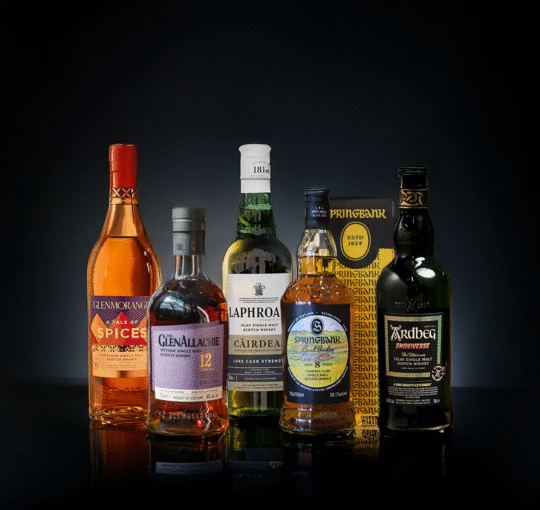
As we reach the latter half of 2025, it's time to look back at the exceptional Scotch whiskies that have graced our shelves and ignited our passion for single malt this year. From heritage barley experiments to award-winning expressions, 2025 has delivered some truly spectacular releases that span the breadth of Scotland's whisky-making regions. Whether you're a peat enthusiast, a sherry bomb devotee, or someone who appreciates innovative cask work, this year's lineup offers something extraordinary for every palate. If you're looking to expand your collection or simply indulge in some of the finest Scotch available, here are our top ten best Scotch releases of 2025 that deserve a place on your shelf.
The most anticipated J&A Mitchell annual release continues to set the bar impossibly high, and this year's iteration might just be the best yet. What makes the 2025 release truly special is the shift to Bere barley from High Ranachan farm—a heritage variety rarely seen outside Bruichladdich releases. Heritage barley contains less starch but more proteins and congeners that contribute exceptional flavor and texture. Matured 50/50 in ex-sherry and ex-bourbon casks and bottled at 58.1% ABV, this is Campbeltown at its most elemental. The nose delivers gloopy, oily aromas of old tools, earthy farminess, cocoa nibs, and Campbeltown funk. With water, it transforms into creamy carbonara territory with black pepper. The palate is superbly rich and oily with stunning mouthfeel—malty, farmy, with milk chocolate, black pepper, and beef fat. The finish is creamy and sweet with chocolate, ending on spicy chili and black pepper. While it has youthful edges at 8 years, this is already a masterpiece. This years release sold out almost immediately—but if you find a bottle, it's worth every penny.
When a whisky wins World's Best Single Malt at the World Whiskies Awards, you pay attention. The GlenAllachie 12 Year Old claimed this prestigious title in 2025, marking the second time Billy Walker's Speyside distillery has won (previously in 2021 with its 10-year-old Cask Strength). This year's 12-year-old represents a refinement with adjusted cask proportions elevating an already excellent whisky to world-beating status. Matured in Oloroso, PX, and virgin oak casks, the nose offers complex sweetness with chocolate fudge, dried fruits, and signature Oloroso spice. The palate is rich without being cloying, delivering layers of dark chocolate, stone fruits, and warming spice. Bottled at 46% ABV without chill filtration or added color, blind tastings show the newer release displaying more pronounced chocolate and fig notes alongside citrus character. For a widely available, reasonably priced whisky to win the world's top single malt award is remarkable. This is Speyside excellence in a bottle.
Kilchoman's 20th anniversary deserved something special, and the 2025 Loch Gorm delivers. For the first time, this annually released sherry bomb carries a 10-year age statement—a milestone for both distillery and stock. Comprising just 23 ex-Oloroso sherry butts (20 first-fill, three refill), founder Anthony Wills nailed it: "Loch Gorm is reaching its perfect age, balancing rich sherry notes with our classic Islay spirit." The nose is bold, sweet, and smoky with honey, golden syrup, umami-like savory notes, damp earth, dried mushroom, coastal salinity, and meaty barbecue smoke with charred bacon. The palate is rich and peppery, dominated by ash (Kilchoman's signature—nobody does it better) alongside barbecue notes. Sweetness evolves with apricot jam, honey, and golden syrup balanced by sea spray, salted caramel, toasted nuts, and robust biscuity malt. The finish is long and ashy with bonfire embers smouldering endlessly. Bottled at 46% ABV, non-chill filtered and naturally colored.
The annual Càirdeas is always a highlight, and 2025's offering is a cask strength version of fan-favorite Lore. Marrying five cask types—ex-bourbon, ex-bourbon quarter casks, ex-Oloroso sherry, European oak, and STR casks—this is one of Laphroaig's most complex profiles at the strength whisky makers enjoy. Bottled at 59.6% ABV, non-chill filtered with no added color, retailing around $95. What's remarkable is how drinkable it is despite the proof. The nose is rich and buttery with vanilla cream, salted caramel, cream soda, berries, red licorice, and lemon zest—medicinal peat dialed back from its usual prominence. The palate is creamy, sweet, and syrupy with spearmint, lemon oil, oak spice, and sweet fruitiness beautifully integrated. The mouthfeel is exceptional, and near 60% ABV, it genuinely doesn't need water—testament to expert maturation. You get cigar juice aftertaste and ashy smoke, but sweetness and spiciness remain on top. The finish delivers salt and citrus with deep warmth of spices, wood, pepper, and powerful phenolic tang concluding with sweet citrus. A solid 8/10, extremely quaffable—Laphroaig knocked it out of the park.
Glenmorangie's Tale of series pushes boundaries, and A Tale of Spices might be the best yet. Inspired by spice markets, this marries four cask finishes: Moroccan red wine, new charred oak, Pedro Ximénez sherry, and shaved toasted red wine. It's a dramatic departure from Glenmorangie's bourbon cask tradition, containing no bourbon maturation whatsoever. Bottled at 46% ABV, the nose explodes with anise, eucalyptus, and almonds leading straight to exotic spices. Orange citrus sits in the background combined with almonds and eucalyptus creating perfumed character—really different from typical Glenmorangie. The palate opens with sweetness and cake before spices take over—fresh eucalyptus and anise with ethereal cooling quality. There's curry spice, dried fruit, subtle chocolate, all much stronger than expected. Chili heat dominates with hefty oakiness suggesting considerable age in European oak, peppermint, and PX sweetness. The finish clings with oak tannins, chocolate, black pepper, nice bitterness with sweet touch. This is far from what Glenmorangie typically does, but it's a fascinating, successful experiment showing what happens when a distillery takes real risks.
Oban is arguably Diageo's most boutique distillery, producing just one million liters annually. When Oban launches a cask strength expression, especially a US-only limited edition, it's worth attention. This spends early life in ex-bourbon before finishing over four years in Oloroso and Palo Cortado sherry casks. Bottled at 110.6 proof (55.3% ABV), it's a rare chance to experience Oban's coastal character unrestrained. The nose is deep, sultry, and savory with big sherry delivering oily almonds, dried citrus, apple chips, old leather, and oxidized wine. Salted caramel and buttery sweetness arrive as it opens, though sherry keeps things dry and raisiny. The palate is peppery and bold with round sweetness and silky mouthfeel showcasing currants and grape skin. Tannins and cracked peppercorn add energy alongside orange oil, clove syrup, and milk chocolate. Well-balanced despite sherry dominance—it gets slightly balsamic but never overtakes the distillery profile. The finish brings classic Oban salinity, soft peat smoke, and coastal brine paired with treacle, rancio, and lingering candied cherry. Unlike most Oban expressions to date, earning a solid A- for execution and distinctiveness.
From the elegant decanter and deep red presentation box to the exceptional whisky within, Macallan Rare Cask 2025 is pure luxury. Crafted from the finest, rarest sherry-seasoned oak casks, this reveals an intense sweet raisin note, rich velvety mouthfeel, and exceptional complexity. The Whisky Mastery Team occasionally discovers casks that stand apart—exhibiting intense sweet raisin coupled with incredibly rich, smooth complexity. These hand-selected casks are chosen for rich natural color, distinctive aroma, and luxurious mouthfeel, showcasing perfection when a single note shines. The nose offers cinematic layers with that dominant sweet raisin character defining the expression. On the palate, intense sweet raisin dominates before giving way to vanilla and dark chocolate with layers of light citrus zest adding brightness. The velvety texture envelops the senses, each layer revealing intricate richness—testament to masterful blending. While carrying no age statement and commanding premium pricing, Rare Cask 2025 showcases Macallan's access to world-class sherry casks and ability to create singular, focused flavor profiles. This is indulgent luxury in liquid form—a rare sensory experience to savor, share, and gift.
Some whiskies carry extra weight because of what they represent. This 19-year-old marks master whisky maker Gordon Motion's final release, concluding his remarkable 27-year career. Motion served as Highland Park's creative force for 16 years, establishing the award-winning core range and releasing over 90 limited expressions. For his finale, he selected the most flavorful casks—just nine total yielding only 1,200 bottles worldwide. Three European oak ex-sherry quarter casks, three American oak ex-sherry quarter casks, and three first-fill ex-bourbon barrels. Quarter casks increase wood contact for more flavor impartation, and nineteen years is the upper limit for this cask type—Motion balanced it perfectly. The nose offers complex sweetness with maple syrup, raisins, toasted oak, and poached pear, while peat sits gently in background with coastal minerality. Cinnamon and cloves add punch. The palate sees sherry and peat move forward with dried fruit and oak, while American oak brings silky, creamy texture before vanilla and caramel emerge. The finish delivers cracked walnuts, toasted oak, and pleasant spice. A fitting finale showcasing Motion's signature ability to balance Highland Park's maritime power with sherry elegance.
Dalmore's annual Luminary includes The Rare (52-year-old) and The Collectible—this more obtainable 17-year-old with 20,000 bottles globally. Starting in ex-bourbon, it finishes across seven cask types: vintage Calvados, aged Calvados, Matusalem sherry, Apostoles sherry, Bordeaux, Châteauneuf-du-Pape, and fully matured American oak. Bottled at 49.2% ABV, non-chill filtered with no added color. The nose offers sliced peaches and ripe apricots with vanilla custard and crème brûlée. Peach transitions to cooked fruit with cinnamon while herbal jasmine tea and wintergreen build. The palate brings Honey Buns vibes—icing and sourdough with sticky-sweet viscous mouthfeel. Fruit cup medley follows with preserved peaches, pears, and maraschino cherries. Preserved orange rind adds welcome tartness cutting early sweetness. Back palate delivers spiced undertones—clove, cinnamon, and cardamom with syrup-soaked fruit and citrus peel. The finish offers honey-drizzled, marmalade-coated toast—sweet, yeasty, tart, and charred. Complex, walking the line between cloying and balanced. While not the most distinctive release here, it's solidly executed, earning an A- for layered complexity.
Dr. Bill Lumsden and Ardbeg push boundaries with experimental whisky making. Smokiverse, the 2025 Ardbeg Day release, is the first Ardbeg from "high-gravity" mash—reducing water in the mash tun to magnify acetate esters, creating fruitier, more tropical spirit. Lumsden explains: "By ramping up wort density, we've drawn in fruitier, sweeter flavors from the deepest corners of the mash tun." The result? Vibrant fruity ester notes like smoked bubble gum where peat collides with juicy tropical fruits before sinking into muscovado sugar depths. Bottled at 48.3% ABV (no high-proof version offered), the nose delivers estery fruits immediately—bubble gum, overripe bananas, apricots, and canned apples and pears, all with Ardbeg's heavy smoke. It's equal parts enchanting and weird—a smoked fruit salad character. The palate is almost syrupy with pear and banana laced with caramel and cotton candy. Ultra-sweet bubble gum continues on unctuous body, while the finish is surprisingly underdeveloped with green banana and tinned pears—the fruit salad becoming simplistic. Chewy caramel flan quality endures. Super-sweet Ardbeg is interesting, but here the pendulum swung too far for easy enjoyment. As with some Ardbeg experiments, this remains more novelty than insta-classic—fascinating but not destined for perennial favorite status.
There you have it—the ten best Scotch releases of 2025. From heritage barley experiments that sold out in hours to world championship winners, master distiller farewells, and bold innovations in cask finishing and mash techniques, this year has delivered remarkable diversity and quality across Scotland's distilling landscape. Whether you managed to snag that elusive Springbank Local Barley or you're savoring the award-winning GlenAllachie 12, these whiskies represent the pinnacle of what 2025 had to offer. Here's to the rest of the year bringing even more exceptional drams to our glasses. Slàinte mhath!
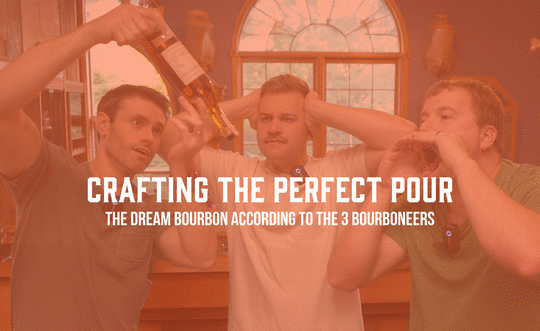
Hey there, whiskey friends. We’re The 3 Bourboneers - just three thirty-something buddies from western Wisconsin with a shared love for great bourbon, questionable hunting stories, and long nights around the fire pit.
Over the years (and many bottles), we’ve had plenty of late-night debates about what makes the perfect bourbon. Is it the proof? The age? The char? The bottle that looks cool on the shelf when your buddies come over for poker night?
Eventually, we decided to put pen to paper and dream it out. So here it is - if we had our pick of the barrel, this is how The 3 Bourboneers would craft our perfect bourbon.
We’ve tasted enough bourbon to know that 12 years is where the magic happens. Not too young, not over-oaked - it’s the sweet spot. After 12 full years in the barrel, you get those rich vanillas, deep caramels, a little tobacco, and all that oaky goodness without it tasting like you’re chewing on a stave. Anything younger feels like it's still figuring itself out. Anything older can get too woody. For us Bourboneers, 12 is the Goldilocks zone.
We’re big fans of a pour with some kick - but not something that singes your eyebrows. 110 proof is where we land every time. It's got enough heat to keep things interesting, but still smooth enough to sip neat after a long day splitting wood or shoveling snow. We’ve found that 100-120 proof bourbons are what we call “crushable” - full of flavor, just the right amount of burn, and always worth a second pour.
Flavor-wise, we tend to gravitate toward what Jim Beam and Heaven Hill are putting out (although Michter’s is in the running lately). There's something about that sweet nuttiness from Beam mixed with the spicy rye-forward kick of Heaven Hill that just hits right. If we were designing a mashbill, it’d blend the best of both worlds. Something corn-heavy with a decent rye backbone and just enough malt to smooth it out. A true Wisconsin blend if there ever was one - traditional, bold, and just a little spicy.
We’re not here for subtle flavors. We want richness. We want depth. We want the bourbon equivalent of a smoked brisket that’s been on the pit for 18 hours. That’s why we’re going with a Level 4 “alligator” char. It brings out all those rich, dark sugars from the oak and layers in that toasted caramel, chocolate, and spice that keeps you coming back. It’s the deep-end of the flavor pool - and that’s where we like to swim.
Look, we love Wisconsin - but when it comes to bourbon, Kentucky is king. They’ve got the limestone water, the seasons, and the history. But more importantly, they’ve got the rickhouses.
If we had our way, we’d age our barrels high up in a Kentucky rickhouse, where the temps swing big and the barrels sweat hard. The more heat and interaction with the oak, the more concentrated the flavor. We’re talking full-send aging.
If you’re going to make a bourbon you’re proud of, you’ve got to dress it up right. We’d go with a tall, elegant wine-style bottle, something along the lines of Eagle Rare or Colonel Taylor.
There’s just something about a bottle that stands taller than the rest on the shelf. It says, “Hey, I’m special,” without yelling it. Plus, it just looks better when you gift it, or pull it out at deer camp to show off a little.
Will we ever actually distill our own bourbon? Who knows. We’re just three guys from Wisconsin who love a good pour and a better conversation. But if we ever do, this is what we’d make - something that reflects who we are: bold, balanced, and built to be shared.
Until then, we’ll keep sampling, sipping, and dreaming - and bringing you along for the ride.
